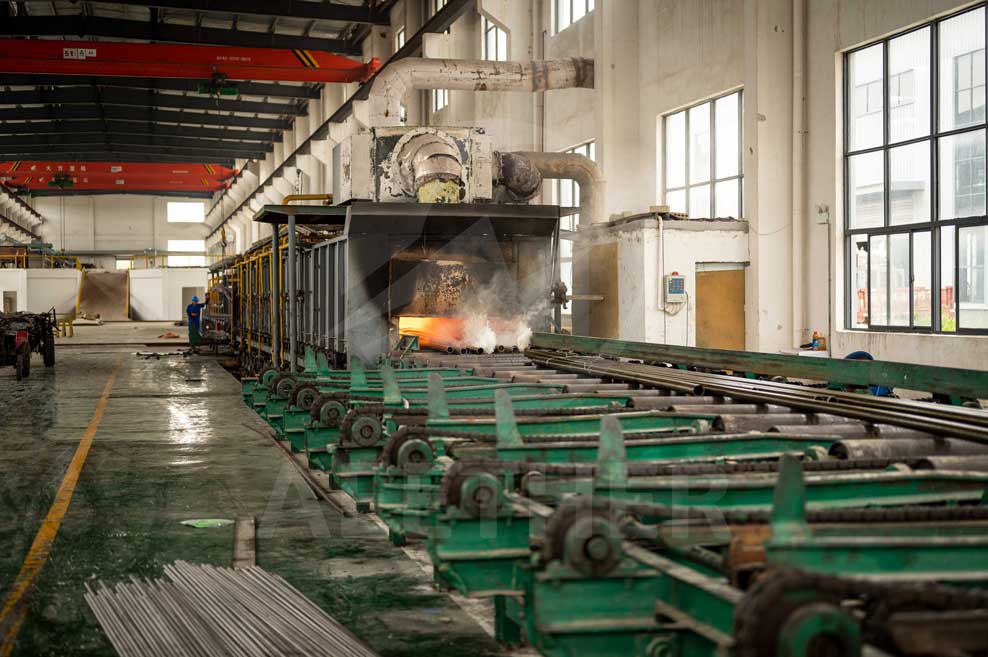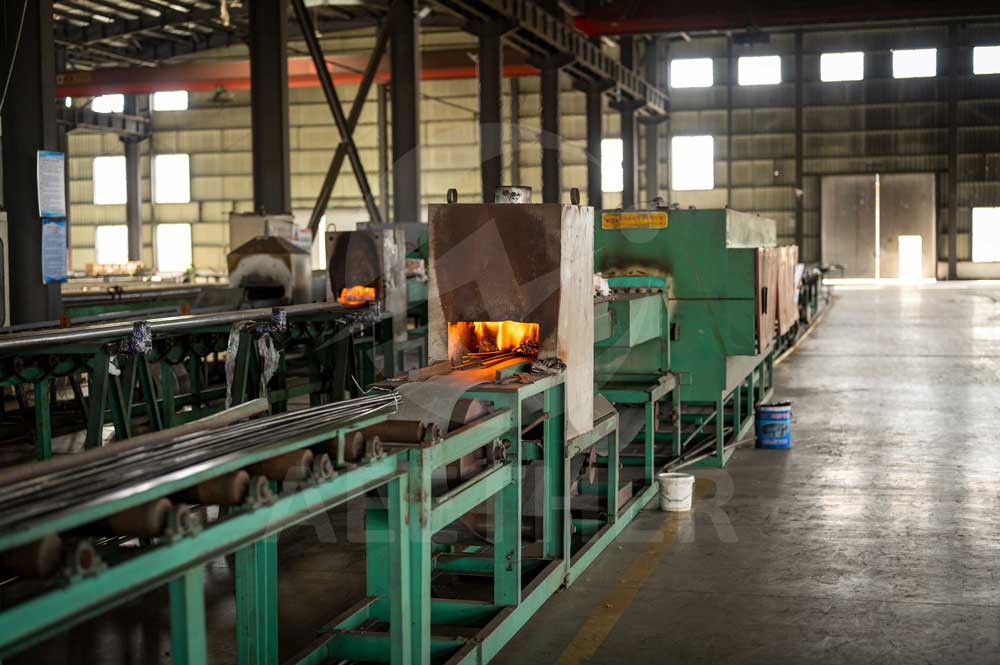Overview
There are many processes in the production of alloys. Different delivery states can be obtained according to the production process of the alloy before delivery. The delivery state determines the properties and surface of the material. In this article, we will introduce the different alloy delivery states one by one, which will allow you to make a better decision when selecting materials.

Processing
The main purpose of processing is to bring the material to a specific size. During this process, the mechanical properties of the material are changed. In most cases, processing increases the strength of the material due to work hardening.
Hot-worked
Hot working is mainly hot rolling and forging. Generally, products with larger dimensions (such as thick-walld pipe, round bar and plate) will be produced in this way. In most cases, this processing method requires the material to be processed and deformed at high temperatures. Hot working is subject to work hardening and recrystallization at the same time. Therefore, hot working can increase the strength of the material to a certain extent, but this improvement is relatively limited.
When these larger-sized products are required to retain a certain strength, the hot-worked state is a more suitable choice. It should be noted that while increasing the strength, the plasticity of the material will decrease.
Cold-worked
Cold working mainly includes cold rolling, cold drawing and other processes. Generally speaking, products with smaller size (such as tube, rod and wire, etc.) can be produced by cold working. Cold working requires extruding and deforming the material at room temperature. Since the material does not recrystallize at room temperature, cold working has only work hardening effect on the material.
The material acquires very high strength after cold working. And the more passes the material is cold-worked, the higher strength it has. If the strength of the material is paramount for your project, the cold-worked delivery condition should be selected.
Forged
Forging involves striking materials at high temperatures to achieve specific sizes and shapes. Strictly speaking, forging is also a kind of hot working. It is also used to make products with larger dimensions. Like hot working, forging also increases the strength of the material. Generally speaking, the material needs to undergo certain surface treatment after forging. The dimensional accuracy of forging is smaller than that of hot rolling.
Heat Treatment
The main function of heat treatment is to change the mechanical properties of materials by heating. It has the potential to increase or decrease the strength of the material.
Annealed
Annealing refers to the process of recrystallizing materials by heating. It can eliminate the work hardening of the material, reduce the material strength and improve the plasticity of the material. In this state, the material is most resistant to deformation and least likely to break when deformed. Annealing is therefore the most common delivery state.

Stress-relieved
The stress-relieved state is a delivery state that not only retains a certain amount of work hardening, but also improves the plasticity of the material. The material attains a stress-relieved state after incomplete annealing. Its principle is similar to annealing, but its heat treatment time is shorter than annealing. The strength and plasticity of the stress-relieved state are between the cold-worked state and the annealed state. It is a delivery state with relatively balanced mechanical properties.
Solution Treated
Solution treatment is also a special annealing. It is also called solution annealing. But its purpose is not to recrystallize, but to fully dissolve the solid solution strengthening elements into the matrix of the alloy. This heat treatment method can significantly improve the performance of the alloy at high temperature. For some materials (such as Inconel 625), different delivery states of the material can be determined according to different service temperatures. Generally speaking, it is delivered in an annealed state when used at room temperature, and delivered in a solid solution state when used at high temperatures.
625
Si
C
Al
Ti
Co
Ta
Mo
Fe
Cr
Ni
Aging Treated
Unlike annealing, aging treatment is a heat treatment method that significantly increases the strength of alloys. Aging treatment is also called precipitation strengthening treatment or precipitation hardening. It is only valid for precipitation strengthened alloys such as Inconel 718. Its principle is the process of placing the material at high temperature for a long time to allow the precipitation strengthening phase to be fully separated from the matrix. The alloy after aging treatment can achieve high strength that cannot be achieved in other delivery states. In some high-intensity applications, the aged state is the best choice.
718
Si
C
Al
Ti
Co
Nb
Ta
Mo
Fe
Cr
Ni
Bright Annealed (BA)
Bright heat treatment is also called bright annealing, it can maintain the bright surface of the material while heat treatment. During ordinary heat treatment, the material is exposed to oxygen and oxidized at high temperature to form a black scale. The bright heat treatment isolates oxygen during the heating process. This prevents the formation of scale, allowing the material to maintain a bright finish when heat-treated. In general, scale is difficult to remove for products with small dimensions or continuous lengths such as coil tube and wire. In this case bright heat treatment should be chosen.

Surface Treatment
The main function of surface treatment is to improve the surface defects of materials and improve the corrosion resistance of materials to a certain extent. At the same time, some surface treatments are also processing. Therefore it also has a work hardening effect.
Pickled (AP)
Pickling is a chemical surface treatment process. During pickling, materials are soaked in an acidic solution. The acidic solution will corrode the scale formed by the material after annealing and form a passive film on the metal surface. The surface after pickling has a white matte texture, which can improve the corrosion resistance of the material. Seamless pipes and plates are often delivered in this state.

Sandblasted
Sandblasted surfaces are very similar to pickled surfaces. Its principle is to impact the surface of the material with high-hardness material powder through high pressure to increase the roughness of the material. Sandblasted surfaces are more uniform in color than pickled. It can improve the mechanical properties of the material surface to a certain extent.
Polished (MP)
Polishing can make the material obtain a bright surface, which is suitable for most materials. In some precision equipment, materials are often required to be delivered with a polished surface. Depending on the degree of polishing, the material can acquire different roughness.

The table below collates a comparison of different surface roughness.
| Ra (micrometers) |
Ra (microinches) |
RMS | CLA (N) | Rt | N | Cut-off Length | |
|---|---|---|---|---|---|---|---|
| inch | mm | ||||||
| 0.025 | 1 | 1.1 | 1 | 0.3 | 1 | 0.003 | 0.08 |
| 0.05 | 2 | 2.2 | 2 | 0.5 | 2 | 0.01 | 0.25 |
| 0.1 | 4 | 4.4 | 4 | 0.8 | 3 | 0.01 | 0.25 |
| 0.2 | 8 | 8.8 | 8 | 1.2 | 4 | 0.01 | 0.25 |
| 0.4 | 16 | 17.6 | 16 | 2 | 5 | 0.01 | 0.25 |
| 0.8 | 32 | 32.5 | 32 | 4 | 6 | 0.03 | 0.8 |
| 1.6 | 63 | 64.3 | 63 | 8 | 7 | 0.03 | 0.8 |
| 3.2 | 125 | 137.5 | 125 | 13 | 8 | 0.1 | 2.5 |
| 6.3 | 250 | 275 | 250 | 25 | 9 | 0.1 | 2.5 |
| 12.5 | 500 | 550 | 500 | 50 | 10 | 0.1 | 2.5 |
| 25 | 1000 | 1100 | 1000 | 100 | 11 | 0.3 | 8.0 |
| 50 | 2000 | 2200 | 2000 | 200 | 12 | 0.3 | 8.0 |
| Ra = Roughness Average in micrometers or microinches RMS = Root Mean Square in microinches CLA = Center Line Average in microinches Rt = Roughness Total in microns N = New ISO (grade) scale numbers Cut-off Length = Length required for sample |
|||||||
Ground
Grinding is mainly suitable for round bar & rod. It is similar to polishing and also gives materials a bright finish. At the same time, grinding can control the size of the material very precisely. In some applications that require high dimensional accuracy of the material, the grinding process is a good choice.

Electropolished (EP)
Electropolishing of the capillary tube may be required in some applications. Electropolishing is a process of electrolyzing the surface of a material with an electrolyte to polish it. The surface after electropolishing will achieve a very high degree of fineness. This surface is demanded only extremely delicate applications are used.

Other Delivery States
Spring Temper
Generally, spring materials (spring wire or spring strip) should be delivered in the state of spring temper. The tensile strength of the material in this state has reached the limit, so that the spring material can withstand large pressure or tension for a long time. In general, the smaller the size of the material, the higher the tensile strength in the spring temper.

Soft, Hard and Half-hard
For strips, different material hardness are sometimes specified. As we said before, the more passes a material is cold-worked, the higher the strength. The more fully the material is annealed, the lower the strength. Strip often needs to go through many times of cold rolling to become a finished product. Therefore, we can control the hardness of the strip through different degrees of heat treatment. Materials are divided into six states from soft to hard: soft, skin-hard, quarter-hard, half-hard, three-quarter-hard and hard. Among them, soft is the fully annealed state, and hard is the cold-worked state.

Conclusion
Metal materials can be obtained in different delivery states in different ways. Common methods are processing, heat treatment and surface treatment. They determine the corrosion resistance, surface and mechanical properties of the material. In practical applications, we can determine different delivery states according to different needs.
We can customize products in different delivery states according to your requirements. If you have needs, you can contact us for a quotation.

